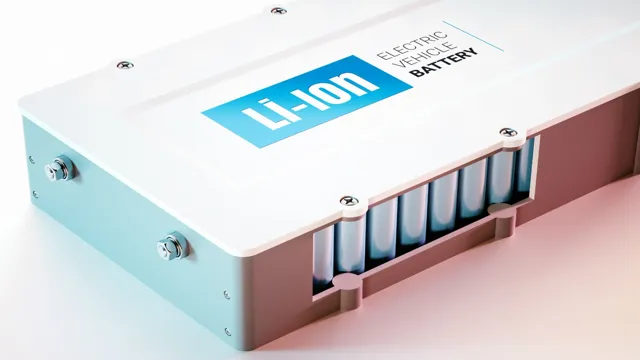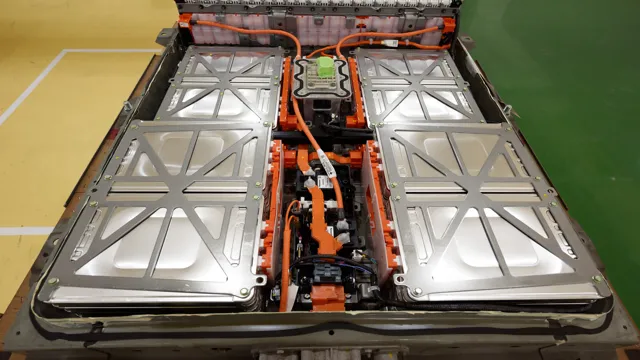Revolutionizing Transportation: The Science behind Electric Car Battery Chemicals
Electric cars have seen a remarkable surge in popularity over the past few years as more and more people seek eco-friendly alternatives to gas-powered vehicles. One of the most essential components of an electric car is the battery, which stores the energy that powers the motor. When it comes to electric car batteries, it isn’t just about the physical structure of the battery itself; the chemicals that make it up play a significant role in determining its efficiency and effectiveness.
Understanding the chemicals that make up electric car batteries and how they function can help us understand the limitations and potential future of electric vehicles. In this blog post, we’ll explore the essential role that battery chemicals play in making electric cars possible.
The Chemistry Behind Battery Technology
When it comes to electric car batteries, there are several chemicals involved in the process. The most common type of battery used is the lithium-ion battery, which contains electrodes made from lithium and a variety of other metals. These metals, such as cobalt, nickel, and manganese, are combined in specific ratios to create a battery that can store a large amount of energy while remaining relatively small and lightweight.
The chemical reaction that takes place inside the battery involves the movement of charged particles, or ions, between the positive and negative electrodes. This movement is facilitated by an electrolyte solution, typically made from a mixture of organic solvents and lithium salts. As the ions flow back and forth, they create a flow of electrical energy that can be harnessed to power an electric car or other device.
While lithium-ion batteries are currently the most common type of electric car battery, there are other technologies being developed that use different chemicals and materials. These include solid-state batteries, which use a solid electrolyte instead of a liquid one, and metal-air batteries, which use oxygen as a reaction partner to create electrical energy. As the field of battery technology continues to evolve and improve, we will likely see even more innovative solutions that use a range of different chemicals and materials to power the cars of the future.
Lithium-ion Batteries and Their Components
The chemistry behind lithium-ion battery technology is fascinating and complex. Lithium-ion batteries contain a cathode, an anode, and an electrolyte. The cathode and anode are typically made of metal oxides and carbon, respectively, while the electrolyte is made up of organic solvents and salts.
When the battery is charging, lithium ions migrate from the cathode to the anode through the electrolyte. During the discharge phase, this process is reversed, and the lithium ions move from the anode to the cathode, producing electricity in the process. The efficiency of these batteries stems from the ability of lithium ions to move rapidly between these electrodes, allowing for high power density and energy efficiency.
The use of lithium-ion batteries has revolutionized the world of portable electronics, electric vehicles, and renewable energy storage, and advances in their composition and production continue to propel innovation in these exciting industries.

Other Types of Electric Car Batteries
There are many different types of electric car batteries available, each with its own unique chemistry and set of benefits. Lithium-ion batteries are the most common and widely used in electric vehicles. They are known for their high energy density, long life-span, and quick charging time.
However, there are other types of batteries that have different chemistries and can be used in electric cars. One example is the nickel-metal hydride battery, which is used in hybrid vehicles. These batteries have a lower energy density than lithium-ion batteries but are more affordable and have a longer lifespan.
Another type of battery is the solid-state battery, which uses solid materials instead of liquid electrolytes. These batteries have the potential to be smaller, lighter, and safer than traditional lithium-ion batteries. Regardless of the type of battery, it’s important to consider its chemistry, energy density, life-span, and other factors when choosing an electric car.
Common Chemicals Used in Electric Car Batteries
Electric car batteries use a variety of chemicals to store energy. One of the most common compounds is lithium, which is prized for its ability to provide a high energy-density while remaining relatively lightweight. Other chemicals used in these batteries can include cobalt, nickel, and manganese.
These materials are typically combined with different types of salts and electrolytes to create a solution that can store and release energy as needed. While the use of these chemicals has helped to make electric cars more practical and efficient, concerns have been raised about the environmental impact of mining and production processes involved in creating them. Nonetheless, as the demand for electric vehicles continues to grow, research into safer and more sustainable battery materials is likely to increase in turn.
Lithium Cobalt Oxide (LiCoO2)
Lithium Cobalt Oxide Electric cars are powered by rechargeable batteries that use a variety of chemicals to store energy. One of the most common chemicals used in these batteries is Lithium Cobalt Oxide, also known as LiCoO This chemical has a high energy density, making it a popular choice for electric vehicles.
The LiCoO2 batteries have a high voltage and long cycle life, making them ideal for electric cars. They offer a good balance between performance and cost, and are widely used in the industry. However, there are some downsides to using LiCoO2, such as safety concerns and environmental impact.
Despite these drawbacks, LiCoO2 batteries are still one of the most widely used chemicals in electric car batteries.
Lithium Iron Phosphate (LiFePO4)
Electric car batteries come in different types, each with unique chemical compositions that provide varying levels of performance and durability. One such chemical commonly used in electric car batteries is Lithium Iron Phosphate (LiFePO4). LiFePO4 batteries have gained popularity in recent years due to their high energy density, which translates to longer drive range and improved acceleration.
This composition also makes them more stable and less prone to overheating or explosion, which is a crucial aspect of electric car batteries. Despite their advantages, LiFePO4 batteries are not without their limitations, such as lower overall energy density compared to other lithium-ion batteries and higher costs. Nonetheless, the use of LiFePO4 in electric car batteries persists and continues to be a viable option for eco-conscious car owners.
Nickel-Metal Hydride (NiMH)
One of the most common types of batteries used in electric cars is the nickel-metal hydride (NiMH) battery. NiMH batteries are popular due to their relatively low cost and their ability to store large amounts of energy. These batteries use a nickel oxide-hydroxide cathode and a metal hydride anode, which allows them to store and deliver energy efficiently.
NiMH batteries are also more environmentally friendly than many other types of batteries, as they do not contain the harmful heavy metals found in other batteries. However, NiMH batteries do have some limitations, such as their tendency to lose capacity over time and their lower energy density compared to other battery types. Despite these limitations, NiMH batteries remain a popular choice for many electric car manufacturers due to their versatility and affordability.
Environmental and Safety Concerns
As electric cars gain popularity, concerns have arisen about the chemicals in their batteries and their impact on the environment and safety. While electric car batteries do contain hazardous materials, such as lithium ion and cobalt, manufacturers have implemented safety precautions to minimize the risk of accidents during the manufacturing and disposal of these batteries. Additionally, research is being conducted to ensure that these chemicals are disposed of in an environmentally responsible manner.
As awareness of these issues increases, manufacturers are also taking steps to design more sustainable and eco-friendly batteries. So while there are still concerns about the use of chemicals in electric car batteries, progress is being made towards mitigating these risks and creating a more sustainable future.
Recycling and Disposal of Electric Car Batteries
As the world moves towards a cleaner and greener future, electric cars have become increasingly popular. However, with the rise of electric vehicles comes the issue of recycling and disposing of their batteries. Electric car batteries contain toxic substances such as lithium, cobalt, and nickel, which can have harmful effects on the environment if not disposed of properly.
The batteries also have the potential to burst into flames if mishandled during the recycling process. To address these concerns, companies are working on developing more environmentally friendly and safer ways to recycle electric car batteries. Proper recycling and disposal of electric car batteries are crucial in preserving the environment and ensuring the safety of workers handling the batteries.
Toxicity of Battery Chemicals
The toxicity of battery chemicals is a major concern for both the environment and human safety. These chemicals, such as lead and lithium, can have detrimental effects on the air, water, and soil if not properly disposed of or handled. Long-term exposure to these chemicals can lead to serious health issues such as respiratory problems, nervous system damage, and even cancer.
It’s important to properly recycle batteries and dispose of them in designated facilities to prevent harm to both our health and the environment. Proper handling and disposal of battery chemicals is crucial in promoting a cleaner and healthier planet. As individuals, we can also make a difference by opting for rechargeable batteries and reducing our overall use of single-use batteries.
Let’s strive to be mindful of our impact and make conscious choices to protect our planet.
Future Developments in Battery Chemistry
As the electric vehicle market continues to grow, new and improved electric car battery chemicals are being developed to increase energy storage capacity and decrease charging time. Lithium-ion batteries have dominated the market for years, but newer technologies like lithium-sulfur and lithium-air batteries show potential for even greater energy density. Researchers are also exploring the possibilities of solid-state batteries, which would eliminate the need for flammable liquid electrolytes and allow for even safer battery operation.
Additionally, more sustainable and eco-friendly materials are being used in battery production, such as sodium and potassium-based chemicals. The race for the most efficient and sustainable electric car battery chemicals is on, and the future looks bright for a more efficient and cost-effective electric vehicle market.
Conclusion
In conclusion, the world of electric car battery chemicals is anything but elementary. With elements ranging from lithium to cobalt, and complex chemical reactions occurring within the battery, it’s no wonder that the development of a reliable and efficient electric vehicle has taken time. But as the demand for sustainable transportation continues to grow, we’re sure to see even more exciting innovations in the field of electric car battery chemistry.
One thing’s for certain: with these advancements, the future of transportation will certainly be electrifying!”
FAQs
What chemicals are used in electric car batteries?
Electric car batteries typically use lithium-ion chemistry, which includes chemicals such as lithium cobalt oxide, lithium iron phosphate, and lithium nickel manganese cobalt oxide.
Are electric car batteries more environmentally friendly than traditional car batteries?
Yes, electric car batteries have a smaller environmental impact than traditional car batteries because they do not contain toxic lead or sulfuric acid.
How long do electric car batteries last?
The lifespan of an electric car battery varies depending on usage and environmental factors, but most electric car batteries have a lifespan of around 8-10 years.
Can electric car batteries be recycled?
Yes, electric car batteries can be recycled. The recycling process typically involves the removal of valuable metals such as cobalt and nickel, which can be reused in new batteries.





